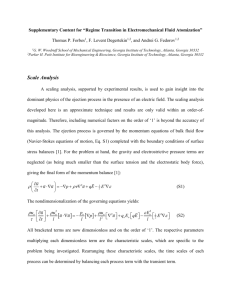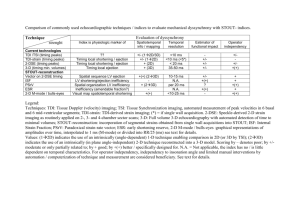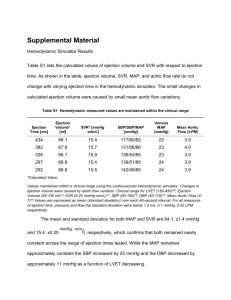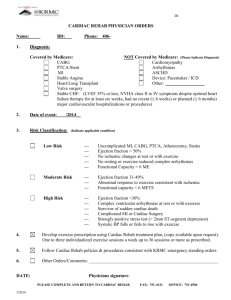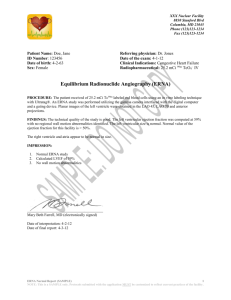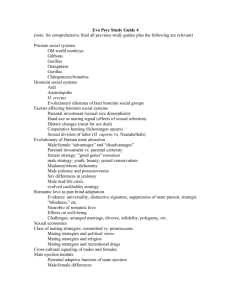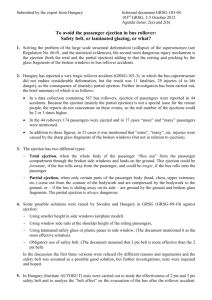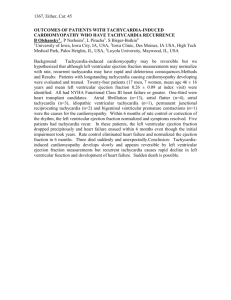The Catholic University of America
advertisement
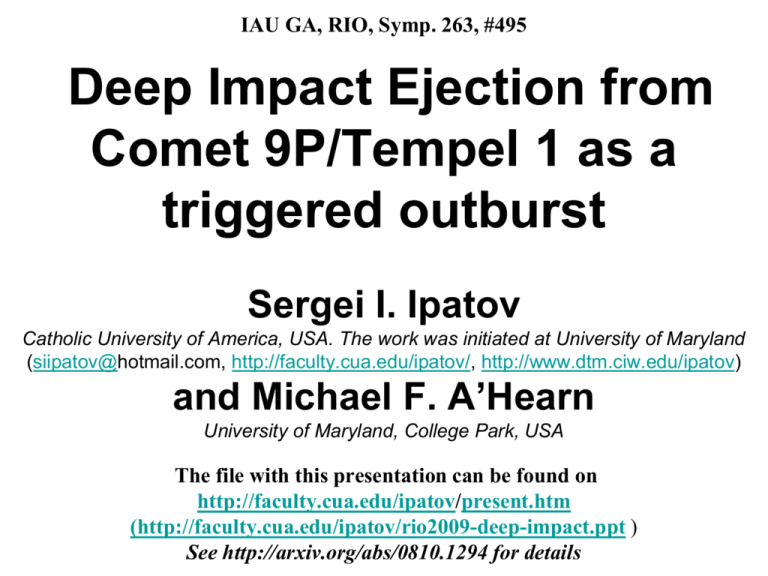
IAU GA, RIO, Symp. 263, #495 Deep Impact Ejection from Comet 9P/Tempel 1 as a triggered outburst Sergei I. Ipatov Catholic University of America, USA. The work was initiated at University of Maryland (siipatov@hotmail.com, http://faculty.cua.edu/ipatov/, http://www.dtm.ciw.edu/ipatov) and Michael F. A’Hearn University of Maryland, College Park, USA The file with this presentation can be found on http://faculty.cua.edu/ipatov/present.htm (http://faculty.cua.edu/ipatov/rio2009-deep-impact.ppt ) See http://arxiv.org/abs/0810.1294 for details Abstract Time variations of velocities and relative amount of material ejected from Comet Tempel 1 are studied [1-2] based on analysis of the images made by Deep Impact (DI) cameras during the first 13 minutes after the collision of the DI impactor with the comet. The rate of production of observed ejected material and velocities considered correspond mainly to small (with diameter d<3 micron) icy particles, and our conclusions were made only for observed small particles. The rate had a peak at ejection time te~0.6 s. At 1<te<3 s and 8<te<40 s, the estimated rate of ejection was essentially greater than for theoretical monotonic exponential decrease. Such difference was caused by that the impact was a trigger of an outburst. At the time te~10 s corresponding to a local maximum of ejection rate, the direction from the place of ejection to the brightest pixel quickly changed by about 50 degrees, a considerable excessive ejection (rays of ejected material) to a few directions began, and typical projections vp of velocities onto the plane perpendicular to the line of sight were ~100-200 m/s. The sharpest rays were caused by material ejected at te~20 s. In particular, there were excessive ejections, especially in images at t~25-50 s after impact, in directions perpendicular to the direction of impact. Directions of excessive ejection could vary with time. A sharp (by a factor of 3) decrease of the ejection rate at te~60 s could be caused by a decrease of the outburst. The outburst could take place at te~10 min because the rays were still observed close to the place of ejection in images at t~500-700 s. Most of the ejected mass and crater volume could be caused by typical cratering, but a considerable fraction of observed mass of the DI cloud could be due to small particles ejected at the triggered outburst. Projections of velocities of most of observed material ejected at te~0.2 s were about 7 km/s. As the first approximation, the characteristic velocity of ejection at te~1-60 s can be considered to be proportional to te in the power of -0.75 or -0.7, but the decrease of velocity could differ from this exponential dependence. The fractions of observed material ejected (at te<6 s and te<15 s) with vp>200 m/s and vp>100 m/s were estimated to be about 0.07 and 0.2, respectively, if we consider only material observed during the first 13 min. These estimates are in accordance with the previous estimates (100-200 m/s) of projection of velocity of the leading edge of the DI dust cloud based on various ground-based observations and observations made by space telescopes. The work was supported by NASA DDAP grant NNX08AG25G. [1] Ipatov S.I., A'Hearn M.F., 2009, LPSC XL, 1022. [2] Ipatov S.I., A'Hearn M.F., 2009, http://arxiv.org/abs/0810.1294 . Introduction • The mass of impactor was 370 kg. Impact speed was 10.3 km/s. The Deep Impact collision with comet 9P/Tempel 1 was oblique: between 25o and 35o deg from the surface horizontal. • Moving particles were accelerated by gas. They can be sublimated and fragmentated. • Our studies of projections vp of velocities on the plane perpendicular to the line of sight and relative amounts of particles ejected from Comet 9P/Temple 1 were based on the images made by the Deep Impact cameras during the first 13 min after the impact. We considered velocities v of the particles that give the main contribution to the brightness of the cloud of ejected material, i.e., mainly of particles with diameter d<3 μm. • We analyzed the distances from a place of ejection to the levels of calibrated physical surface brightness (CPSB, always in W m-2 sterad-1 micron-1) of a cloud of ejected material on RADREV images. • Real velocity can be greater by a factor of 1.5-2 than the projection of velocity on the plane perpendicular to a line of sight. • If the same amount of material moves from distance D1 from the place of impact to distance D2, then the number of particles on a line of sight (and so the brightness) decreases by a factor of D2/D1. • Ejected particles become cooler with time and so they become less bright. 3 Series of DI images considered. In each series, the intergration time and the size of image were the same. For series Ma, Ha, and Hc, we analyzed the differences in brightness between a current image and that before the impact. These series are marked by “(dif)”. For other series, we analyzed the brightness in current images. Series Instrument INTTIME, Size, pixels seconds EXPID min, max IMPACTM, seconds min, max Ma (dif) MRI 0.0514 64×64 9000910, 9000910 0.001, 5.720 Mb MRI 0.3 1024×1024 9000942, 9001067 77.651, 802.871 Ha (dif) HRI 0.1 512×512 9000910, 9000945 0.215, 109.141 Hb HRI 0.6 1024×1024 9000931, 9001002 39.274, 664.993 Hc (dif) HRI 0.6 512×512 9000927, 9000942 27.664, 86.368 Hd HRI 0.1 1024×1024 9000934, 9000961 50.715, 251.525 He HRI 0.5 1024×1024 9001017, 9001036 719.805, 771.95 4 Variation of the relative brightness Br of the brightest pixel with time t. For construction of the figures, we took into account that due to not ideal calibration, maximum brightness on images made at different exposure times, but at approximately the same time, can differ by tens of percent. It is considered that Br=1 at t=4 s. Besides peaks during the first second (e.g., at 0.6 s), there was an increase of brightness after 10 s. 5 (a) The left figure. Coordinates x and y of the brightest pixel relative to the position of the brightest pixel in the MRI image at t=0.001 s (the place of impact) at different times after the impact. (b) The right figure. The angle (in degrees) of the direction from the brightest pixel at t=0.215 s (close to the place of ejection) to the brightest pixel at a current time. The angle corresponding to the direction of the impact was about -60o. A jump of direction of ejection in images at t~12-13 s and te~10 s. 6 Contours corresponding to CPSB (calibrated physical surface brightness) equal to 1, 0.3, 0.1, and 0.03, for MRI images from series Mb made 77.651 (a), 138.901 (b), 191.53 (c), 311.055 (d), 351.043 (e), and 410.618 s (f) after the impact. 7 Rays of ejected material • The excess ejection of material to a few directions (rays of ejected material) was considerable during the first 100 s, took place during several minutes, and was still observed in images at t~500-770 s. It shows that the outburst continued up to ~10 min. • Considerable excessive ejection (the outburst triggered by the impact) began approximately at the same time te~10 s when the direction from the place of ejection to the brightest pixel changed, the peak brightness began to increase, and there was a local peak of the rate of ejection. • The sharpest rays were caused by material ejected at te~20 s. • The upper-right excessive ejection (perpendicular to the direction of impact ) began mainly at te~15 s (though there was some ejection at te~2 s), could reach maximum at te~25-50 s, could still be considerable at te~100 s, but then could decrease, though it still could be seen at te~400 s. The value of te~15 s is correlated with the changes of the direction to the brightest pixel at t~12-13 s. • The upper bump of the outer contours is clearly seen at 66<t<665 s, especially, in at t~200-350 s. The direction from the place of impact to this bump is not far from the direction opposite to the impact direction. 8 Time variations of sizes L (in km) of regions inside contours of CPSB=const. The curves have local minima and maxima that were used for analysis of time variations of velocities. Based on the supposition that the same particles correspond to different local maxima (or minima) of L (e.g., to values L1 and L2 on images made at t1 and t2), we calculated the characteristic velocities v=(L1-L2)/(t1-t2) at te=t1-L1/v. The number after a designation of the series in the figure legend shows the value of brightness of the considered contour. For series Ma, we considered L as the distance from the place of impact to the contour down in y-direction. For other series, we considered the difference between maximum and minimum values of x for the contour. 9 Typical projections vmodel of velocities (in km/s) on the plane perpendicular to the line of sight at time te of ejection for the model when velocities vmodel at te are the same as velocities vexpt=c×(t/0.26)-α of the edge of observed bright region at time t. The distance from the place of ejection to the edge was used to find the dependence of t on te. As the first approximation, the characteristic velocity at te>1 s can be considered to be proportional to te-0.75 or te-0.7 (i.e. α~0.7-0.75; 0.71 corresponds to sand; 0.75, to the ejection mainly governed by momentum). The values of vyobs and vxobs are based on analysis of local minima and maxima of plots on the previous slide. 10 • Models of ejection Ejection of material from Comet Tempel 1 was studied based on analysis of the images made by the Deep Impact cameras. Our studies presented in [1-2] and in this presentation (including all the figures) were based on very simple calculations. Complicated models depend on many factors, and we consider that it is better first to understand the general features of the ejection. If we began our studies with complicated models, we could find at what parameters, theoretical models better fits the observations, but might not understand the role of the triggered outburst and that the DI ejection was far from the theoretical models. • This year we began to construct and use more complicated models of ejections. The future models will take into account several factors (including sublimation and destruction of moving particles) and will simulate the observations of 3D cloud of ejected material. The current model is still relatively simple, and it is a step to the construction of complicated computer models of the DI ejection, which will allow one to understand better the process of ejection and the role of different factors on the evolution and observable form of the ejected cloud. • A velocity of ejection is considered to be proportional to the time te of ejection in the power of α. The time of ejection was divided into intervals corresponding to successive images. For each interval (beginning from smaller times), based on the distances from the place of ejection to the levels of brightness close to the place of ejection, we find the relative amount dm of ejected material. Using also the distances to more far levels of brightness, we find α that better fit the observations. As a result, we obtain the dependence of dm and α on te. The preliminary results are in general accordance with the studies presented in [1-2]. [1] Ipatov S.I., A'Hearn M.F., 2009, LPSC XL, 1022. [2] Ipatov S.I., A'Hearn M.F., 2009, http://arxiv.org/abs/0810.1294 . 11 The relationship between time of ejection and time when we consider the edge of the bright region (left figure). Volume of the bright region (typically with CPSB>3) at different times of images (right figure). Considering that the time needed for particles to travel a distance Lr to the edge of the region is equal to dt=Lr/vexpt (where vexpt=vp=c×(t/0.26)-α), we found the time te=tdt of ejection of material of the contour of the bright region considered at time t. Based on the values of Lr, we calculated the values of the relative volume Vr=Lr3 of material inside the bright region and the relative rate rte=Lr3×t-α of ejection (which is proportional to Vr×vexpt(t)) for α=0.6, α=0.644, α=0.71, and α=0.75. Based on these two figures, we obtain relationships of Vr and rte on te. 12 Relative rate of ejection at different times te of ejection for the model in which characteristic velocities of the edge of the observed bright region at time t are equal to vexpt=c×(t/0.26)-α. The impact was a trigger of an outburst. At te~1-60 s the rate of ejection was mainly greater than that for theoretical models, and instead of monotonic decrease of the rate predicted by theoretical models, there was a local maximum of the rate at te~10 s with typical projections of velocities vp~100-200 m/s. There was a sharp decrease of ejection rate (and of the outburst) at te~60 s. Our studies do not contradict to a continuous ejection of material during at least 10 minutes after the collision. 13 Relative amount fev of material ejected with velocities greater than v vs. v for the model in which characteristic velocities of the edge of the observed bright region at t are equal to v=vexpt=c×(t/0.26)-α for five pairs of α and c. fev=1 for material ejected before te corresponding to the edge of the bright region at t=803. At velocities of several tens of meters, the model amount is greater than for theoretical estimates. Exponents of the velocity dependence of the relative volume fev of material ejected with velocities greater than v, equal to -1, -1.23, -1.66, and -2, correspond to α equal to 0.75, 0.71, 0.644, and 0.6, respectively. α=0.71 is for sand, and α=0.6 is for basalt. 14 Triggered outburst • The rates and velocities of material ejected after the DI impact were different from those for experiments and theoretical models. Holsapple and Housen (2007, Icarus 187, 345-356) concluded that the difference was caused by vaporization of ice in the plume and fast moving gas. In our opinion, the greater role in the difference could be played by the outburst triggered by the impact (by the increase of ejection of bright particles), and it may be possible to consider the ejection as superposition of the normal ejection and the triggered outburst. There was not only the increase of velocities compared to theoretical models, but also there was the increase of the rate of ejection. • Due to the outburst, at te~1-60 s the rate of ejection was mainly greater than that for theoretical models. During this time the fraction of ejected icy particles could be greater than that at other time of ejection. The outburst was maximum at time te of ejection ~10 s. There could be a sharp decrease of the outburst at te~60 s. • The increase of the fraction of icy material caused the increase of the ejection rate and the initial velocities. Evaporation and sublimation of this ice increased velocities of moving particles. The contribution of the outburst to the brightness of the cloud could be considerable, but its contribution to the 15 ejected mass could be relatively small. Conclusions • Our studies of the projections vp of velocities of ejected material onto the plane perpendicular to the line of sight and the relative amounts of particles ejected from Comet 9P/Temple 1 were based on the images made by the Deep Impact cameras during the first 13 min after the impact. We considered velocities of the particles that give the main contribution to the brightness of the cloud of ejected material, i.e. mainly of particles with diameter d<3 μm. • There was a maximum of production of observed ejected material at time of ejection te~0.6 s. There was a local maximum of the rate at te~10 s with typical projections of velocities vp~100-200 m/s. At 1<te<3 s and 8<te<40 s the estimated rate of ejection of observed material was essentially greater than that for theoretical monotonic exponential decrease. Such difference was caused by that the impact was a trigger of an outburst. There could be a sharp decrease of the outburst at te~60 s. Our studies do not allow one to estimate accurately the time of the end of ejection. They do not contradict to a continuous ejection of material during at least 10 minutes after the collision. Material of the nucleus ejected during the first second could be more solid than that ejected 16 after the first second. Conclusions • • Projections of velocities of most of observed material ejected at te~0.2 s were about 7 km/s. As the first approximation, the time variations of characteristic velocity at 1 s < te < 60 s can be considered to be proportional to te-0.75 or te-0.71, but they could differ from this exponential dependence. The fractions of observed material ejected (at te≤6 s and te≤15 s) with vp≥200 m/s and vp≥100 m/s were estimated to be about 0.07 and 0.2, respectively, if we consider only material observed during the first 13 min. These estimates are in accordance with the previous estimates (100-200 m/s) of projection of velocity of the leading edge of the DI dust cloud based on various ground-based observations and observations made by space telescopes. The excess ejection of material to a few directions (rays of ejected material) was considerable during the first 100 s, and it was still observed in images at t~500-770 s. It shows that the outburst continued after 60 s and could be at te~10 min. Considerable excessive ejection began approximately at the same time te~10 s when the direction from the place of ejection to the brightest pixel changed by 50o, the peak brightness began to increase, and there was a local peak of the rate of ejection. The direction from the place of impact to the brightest pixel was mainly close to the direction of the impact in images made during the first 10-12 s, then quickly changed by about 50o, and then slowly became closer to the direction of the impact. The sharpest rays were caused by material ejected at te~20 s. In particular, there were excessive ejections, especially in images at t~25-50 s after the impact, in directions perpendicular to the direction of the 17 impact. Directions of excessive ejection could vary with time.
